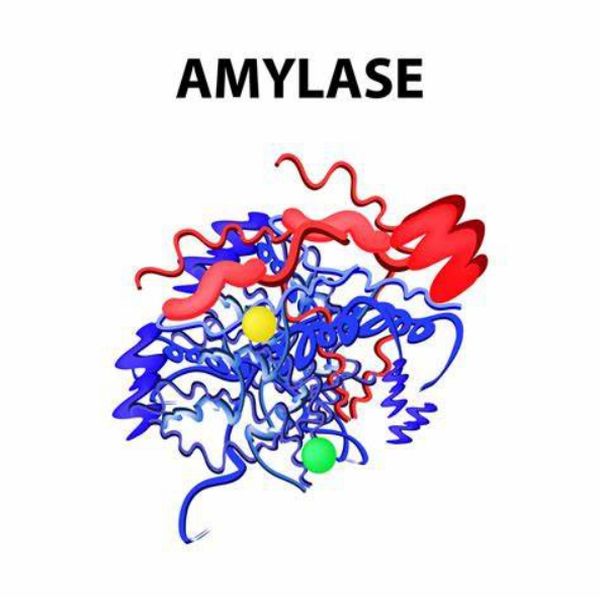Amylase is an enzyme that breaks down starch, converting it into sugar. There are two major types: alpha and beta. Alpha-amylase is found in human saliva, where it begins a chemical process in digestion with the hydrolysis of starch. It is also found in the pancreas. Beta-amylase is found in the seeds of some plants, as well as bacteria, yeast, and molds. Amylase is also found in other animals that use it to aid the digestive process.
It is mainly used to improve the dough in bread production (reduce the dough viscosity, accelerate the fermentation process, increase the sugar content, ease the aging of bread). Pretreatment of cereals in infant food (starch hydrolysis); For saccharification and decomposition of undecomposed starch Chemicalbook in beer making; Liquefaction and saccharification of starch in sake production; Saccharification and decomposition of undecomposed starch in alcohol industry; Starch decomposition in juice processing and increase filtration rate; And vegetable processing, syrup production, caramel production, powder dextrin, glucose and other processing and manufacturing.
Medical professionals and labs can use amylase as a means of detecting pancreatic disorders through blood and urine tests. Varying levels of the enzyme in the blood stream can indicate whether a person is suffering from pancreas-related disorders, such as pancreatic cancer or gallbladder attacks. Levels in urine can also help detect problems with kidney function.
Beta-amylase separates maltose disaccharides, or malt sugar, from starch. Some vegetables and many fruits taste sweet in part because of the role that the enzyme plays to break starch down into sugar. This is one reason why sweet potatoes have their signature sugary taste.
Industrial processes, such as the brewing of beer, use beta-amylase. The enzyme, secreted from yeast, breaks up the maltose compounds in barley, turning it into malted barley, and thereby aiding the fermentation process. Its presence in yeast is also the reason why amylase often plays an important role in bread making, where it breaks down starch, adds flavor and leavens dough.
Other industries use amylase as well. The clothing industry uses the enzyme to soften starch in fabric, so denim jeans aren’t stiff as a board. It also is used as a key ingredient in laundry fabric softener.
The amylase must work together with other enzymes to break down starchy carbohydrates and allow molecules to be absorbed. The body’s capacity of absorbing dietary starches is inhibited by starch blockers, amylase inhibitors that are composed of various materials. Even though some individuals recommended amylase inhibitors as an efficient weight loss product, preliminary research showed that it is not very successful at stopping the carbohydrates to be absorbed.
Pancreatic amylase activity by the pancreas to state in the digestive tract, is one of the most important enzyme hydrolysis of carbohydrates, and belong to alpha amylase secretion of the salivary glands of amylase, acting on the alpha 1, 4 glycosidic bond, the branches on the alpha 1, 6 glycosidic bond has no effect, so it is also said in the starch enzyme, the role of the optimum pH is 6.9, but through the glomerular filtration, is the only can appear in normal in the urine of plasma enzymes.
Amylase activity was found in extracts from other tissues of the body such as ovary, fallopian tube, lung, testis, semen and breast. Amylase is also found in blood, urine and lotions. The blood amylase mainly comes from the pancreas and salivary glands, and the urine amylase comes from the blood.
When the isozyme of serum amylase was measured, two main isozyme zones and several secondary zones were found. One of the two main zones is the same as the purification or secretion of the pancreas, so it is named p-isoenzyme. The other is in the same position as the salivary gland refinement or salivary electrophoresis, hence the name s-isozyme. The determination of amylase isozyme is helpful for the differential diagnosis of pancreatic diseases.
Post time: Apr-26-2020
